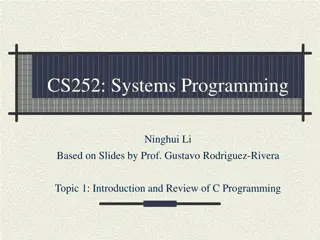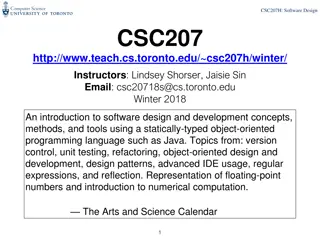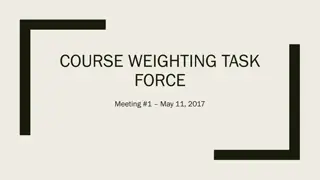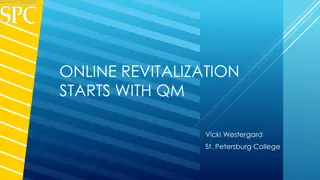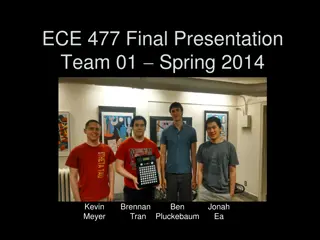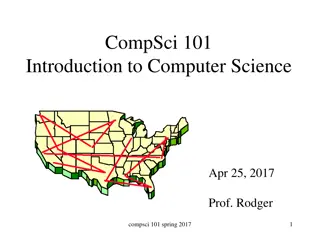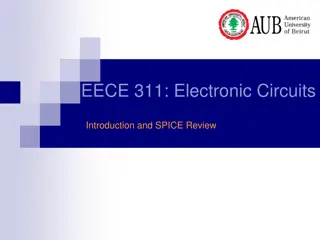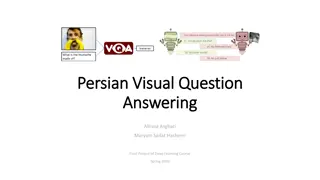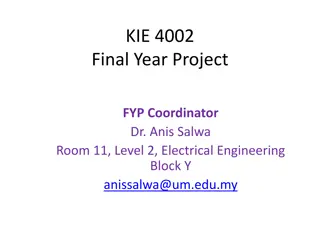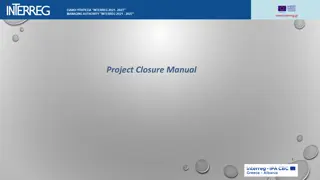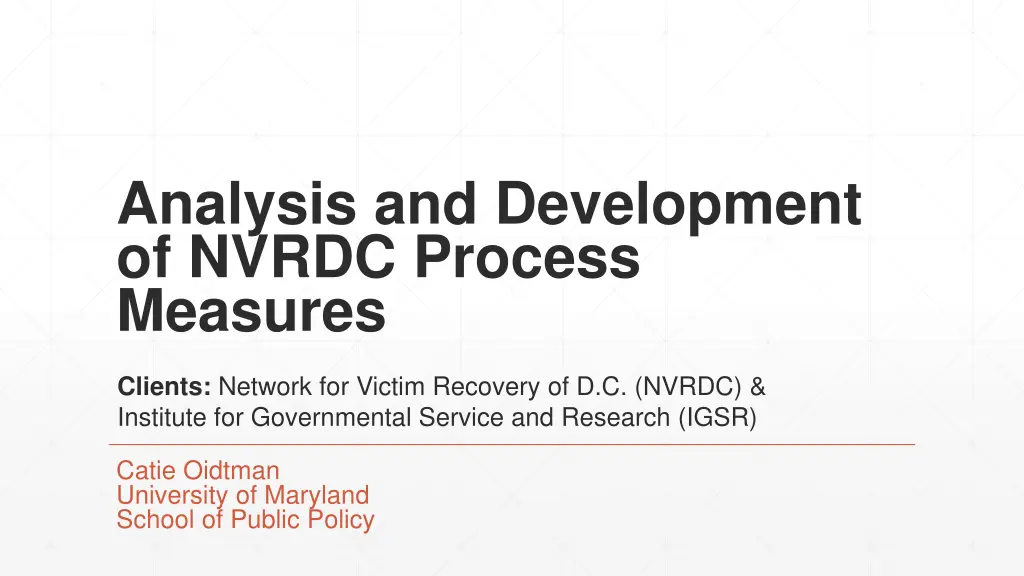
NVRDC Process Measures Analysis
Explore the analysis and development of process measures at NVRDC, focusing on client services, advocacy, and case management. Discover key actions, assess data, and make recommendations for improved service delivery.
Download Presentation

Please find below an Image/Link to download the presentation.
The content on the website is provided AS IS for your information and personal use only. It may not be sold, licensed, or shared on other websites without obtaining consent from the author. If you encounter any issues during the download, it is possible that the publisher has removed the file from their server.
You are allowed to download the files provided on this website for personal or commercial use, subject to the condition that they are used lawfully. All files are the property of their respective owners.
The content on the website is provided AS IS for your information and personal use only. It may not be sold, licensed, or shared on other websites without obtaining consent from the author.
E N D
Presentation Transcript
Analysis and Development of NVRDC Process Measures Clients: Network for Victim Recovery of D.C. (NVRDC) & Institute for Governmental Service and Research (IGSR) Catie Oidtman University of Maryland School of Public Policy
Background NVRDC empowers victims of all crimes by providing advocacy, case management, and legal services NVRDC was founded in 2012 Collected data has not previously been analyzed Case managers and advocacy services Focus on SACRP data
Purpose To determine the current process measures in place for NVRDC Case Management Services To assess key actions Case Managers must perform regularly to provide optimal service to clients To analyze data collected on the current process measures said to be in place To develop additional process measures where relevant and make recommendations on how to better capture data for current process measures
Methodology Analysis of NVRDC Materials and Manual Focus Group Analysis of NVRDC Administrative Data Efforts to Outcome (ETO) Data and Hospital Time Logs Development of Additional Performance Measures
Client Demographics N Freq. Percent N Freq. Percent 1668 Age 0 to 19 years old 20 to 29 years old 30 to 39 years old 40 to 49 years old 50 to 59 years old 60 to 69 years old 70 to 79 years old 80 to 89 years old 1609 Gender Woman/Female/Feminine-of-Center Man/Male/Masculine-of-Center Transgender Female/Trans Woman/MTF Transgender Male/Trans Man/FTM Gender Queer/Non-Binary Other Unknown 47 873 436 155 96 39 17 5 2.8% 52.3% 26.1% 9.3% 5.8% 2.3% 1.0% 0.3% 1418 152 84.8% 9.1% 3 0.2% 21 1 3 11 1.3% <0.1% 0.2% 0.7%
Client Characteristics N Freq. Percent 1868 N 1643 Freq. Percent Client Status New Returning Was Crime Reported? Yes No Not Applicable SANE Exam Completion Exam (Includes if ANY part of exam was performed) Exam Exempt Not Applicable Other 1691 177 90.5% 9.5% Race/Ethnicity Black/African American White Non-Latino/Caucasian Hispanic/Latino Asian American Indian/Alaska Native African Native Hawaiian/Other Pacific Islander Two or More Races Other Unknown 923 410 107 41 5 5 56.2% 25.0% 6.5% 2.5% 0.3% 0.3% 1820 1223 581 16 67.2% 31.9% 0.9% 1784 2 0.1% 1468 82.3% 89 33 28 5.4% 2.0% 1.7% 249 19 48 14.0% 1.1% 2.7%
Structure of Findings Criteria to assess each current process measure: Is the standard measured ? Was the standard met? Is the standard realistic? Criteria 1 Criteria 2 Criteria 3
Answer Rate for SACRP Calls 100% answer rate for SACRP calls Standard Met? ?? Standard Realistic? Yes Standard Measured? No Most important process measure Not tracked by ETO: Lindsey gets an email each time a call comes through Recommend: Creating a data point to record each time a call is received
Response Time to Calls 100% of hospital calls offering advocacy services will be responded to by an NVRDC advocate within 1 hour of receiving call. Standard Met? Standard Realistic? No Post focus group discussion, recommended new performance standard: respond within 1 hour 80% of the time. Standard Measured? Rates of recording for data used to calculate standard: Activation Times 99.2% (747 of 761) Arrival Time to Hospital 92.9% (707 of 761) No - 81.7% (573 of 701) Yes N=761
Uber Ride to Hospital Uber Ride to Hospital 100% of survivors requesting transportation to the hospital will be provided a free Uber ride coordinated by on-call NVRDC Advocate Valid Percent 89.6 Freq. Percent 1562 83.5 No: 181 10.4 9.7 Yes: 1743 100 93.2 Total: Recommend: check box of if survivor requested ride: Y/N 128 6.8 Missing: 1871 100 N: Standard Met? ?? Standard Realistic? Yes Standard Measured? No
Uber Ride from Hospital 100% of survivors requesting transportation home from the hospital will be provided a free Uber ride coordinated by NVRDC Advocate assigned to their case. Uber Ride from Hospital Valid Percent 51.9 Freq. Percent 894 47.8 No: 830 48.1 44.4 Yes: 1724 100 92.1 Total: Recommend: check box of if survivor requested ride: Y/N 147 7.9 Missing: 1871 100 N: Standard Met? ?? Standard Realistic? Yes Standard Measured? No
Clients with LEP or NEP 100% of survivors that are Limited English Proficient (LEP) or Non-English Proficient (NEP) are offered Ayuda emergency interpreter services either in person or via phone. Standard Met? ?? Standard Realistic? Yes Standard Measured? No Client Received Assistance from Ayuda Valid Percent Freq. Percent 14 63.6 36.4 100.0 14 No Yes Total Missing N: Recommend: Adding a touchpoint in ETO to check Y/N that clients were offered Ayuda services 8 8 22 22 12 3 25 100
Info on Clients that Reported For 95% of cases in which survivors reported to police, there will be a CNN number and the detective s name. Standard Met? No 20.1% Standard Realistic? Standard Measured? ?? (246 of 1223 of CNN #s reported in ETO) No 91.2% (1115 of 1223 of detective names reported in ETO) Depends on why there is so much missing data for CNN #s Yes Very low numbers of reporting for CCN #s
Medical Record and Client ID 100% rate of recording of medical record number and client ID of survivors receiving SANE exam. Standard Met? No 81.1%* (1191 of 1468 Medical Record #s recorded) Standard Realistic? Standard Measured? No There will likely be some level of data entry error, so a better standard would be 97- 98% Yes No 80.7%* (1185 of 1468 Client ID #s recorded) 30 cases with .00 as answers could be data entry error
Follow-Ups with Clients NVRDC advocate will attempt a follow up with 100% of survivors who received a SANE exam within 2 business days of completed exam via phone or email Limitations to this data analysis Assumption made: Needs Assessment is primary data set Only includes clients followed up within 1-30 days Standard Met? No 5 days follow-up on average* Standard Realisitc? Yes Standard Measured? Yes but there are many problems with how it is currently measured
Additional Information on Follow-Ups 397 clients in Contact data but not Needs Assessment Large gaps in time before first follow-up Recommendations: Add variable to signify outcome of the contact Add a drop down for what kind of contact is being made (referral, follow-up, etc.)
Barriers to Recording Data Recording data via a laptop detracts from personable interaction with survivor ETO database in not mobile friendly Problem with Internet at hospital ETO malfunctions and wipes data clean
Additional Recommendations HanDBase Mobile app that is adaptable to ETO database Move from a pre-post resiliency scale to an empowerment model Aligns better with NVRDC mission Very few post-resiliency scales collected
Additional Relevant Findings Dispatch process is currently being changed Combining the 3 call centers into one This may impact process measures dealing with recording information from specific calls NVRDC is slow to dismiss clients Fear they will think they are not welcome to call again Impacts post-resiliency data collection
Thank you. Questions?









